Downlights are getting famous for both residential and commercial lighting. But all of them are not suitable for every type of ceiling. For example- placing a non-IC-rated downlight on an insulated ceiling can be dangerous. That is why choosing the right downlights is essential.
Downlights are installed into the ceiling to throw downward lighting. You can use them for general lighting, tasks, or decorative lighting. However, to choose the downlights, you must consider factors like- ceiling height, beam angle, downlight spacing, IC & IP rating, and more. Besides, the downlights’ installation process differs from other lightings as they attach directly to the ceiling.
But there is nothing to worry about. In this article, I will guide you on downlights, their types, and ways to choose the ideal one. You will also find quick installation and maintenance guidelines. So, without any further delay, let’s start our discussion-
What are the Downlights?
Downlights are designed to project downward illumination. These lights are often known as canister lights. Downlights are fitted into the ceiling facing downward, spreading even lighting all around. Usually, these lights come in smaller sizes. So, when multiple downlights are installed in a ceiling, it gives excellent ambient lighting. Besides, downlights are ideal for accent or Task lighting also. Moreover, these lights come in different varieties and styles, suitable for providing a modern approach to your lighting area. And this makes these lights so popular for residential and commercial lighting. For more information, you can read What is the Difference Between Floodlight, Spotlight, and Downlight?
Types Of Downlight
You can classify downlight based on two factors- based on the mechanism & based on the installation process. The types of downlights based on these factors are as follows-
Based On Mechanism
Downlights can be of three types depending on the lighting pattern and mechanism. These are-
- Fixed Downlight
Fixed downlights are the cheapest and most common type of lights. They are installed directly into the ceiling, pointing downwards. The intensity of these lights depends on the bulb inside the globe of the fixture. The lower the beam angle greater the intensity of the light. For example- a fixed downlight with a 40° beam angle produces a brightness of 37fc. But when you increase the beam angle to 120°, the intensity is lowered to 17fc. However, the lighting area increases with the beam angle. Professionals usually suggest placing multiple downlights at 40° for adequate ambiance lighting.
- Adjustable Downlight
These lights are highly functional due to their angle adjustment facilities. You can move them in various directions as per your lighting requirements. However, the range for angle adjustability varies from brand to brand. If you are looking for focus lights to highlight a particular area of your house, these lights will work great. But these lights are mostly considered a luxury, which is not always true. Besides accent lighting, you can also use these adjustable downlights as task lighting. For example- if you have paperwork, you can angle the fixture toward your workstation. And these versatile functionalities make adjustable downlights popular these days.
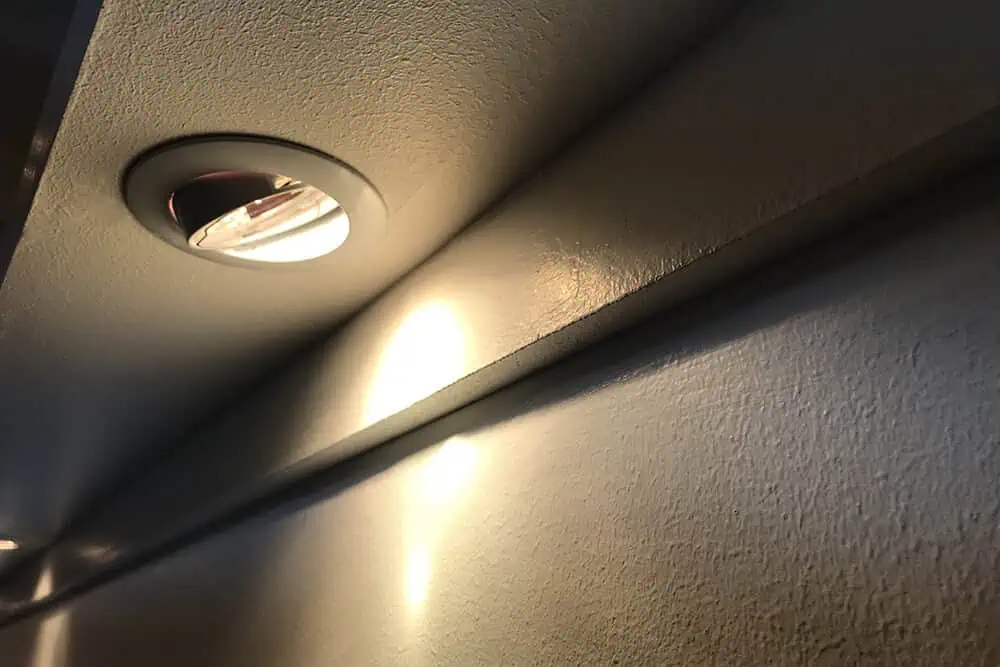
- Dimmable Downlight
Lighting requirements vary for different sections of your room. Besides, the need for light intensity also differs with daytime and tasking. For example, when studying in your room, lighting with a higher brightness level is essential. But such lighting can be disturbing when relaxing and on your bed. In this situation, dimmable downlights will meet all your lighting demands. You can adjust the intensity of the light to your needs and mood.
Based On the Installation Process
All downlights are not installed following the same procedure. And based on their installation, downlights can be classified into three major types. These are as follows-
- Recessed
Recessed lights are downlights that are attached directly to the ceiling. These lights are designed for false ceilings, where you can make holes and insert fixtures. You will find two types of recessed lighting based on the installation area- IC and non-IC rated. This rating is a must-have consideration when purchasing recessed lights, especially when you have an insulated house. LED recessed lights are excellent as downlights. They are energy efficient and easy to install. You can mount them on the ceiling with spring clips or compressor clips. All you need to do is push the fixture vertically into the holes. As you insert the fitting, springs are pressed downwards onto the ceiling, securing the downlights.
For more information, you can check IC Vs. Non-IC Rated Recessed Light Fixtures.
- Surface Mounted
Surface-mounted downlights are installed in the concrete ceiling. You can quickly fix them with the supplied brackets. So, with these downlights, you need not take the extra hassle of making holes in the ceiling. Thus, the installation process is more straightforward compared to recessed ones. These types of downlights are available in different sizes. Besides, they are great for ambient lighting. If you are looking for general lighting for your house, surface-mounted recessed lights will work great.
- Suspended
Suspended downlights remain hanging from the ceiling height—for example- Eclipse surface downlights. These lights add an extra visual effect to your lighting. You can use them in your living area, hallway, reading room, and more. These lights are also ideal for restaurant lighting.
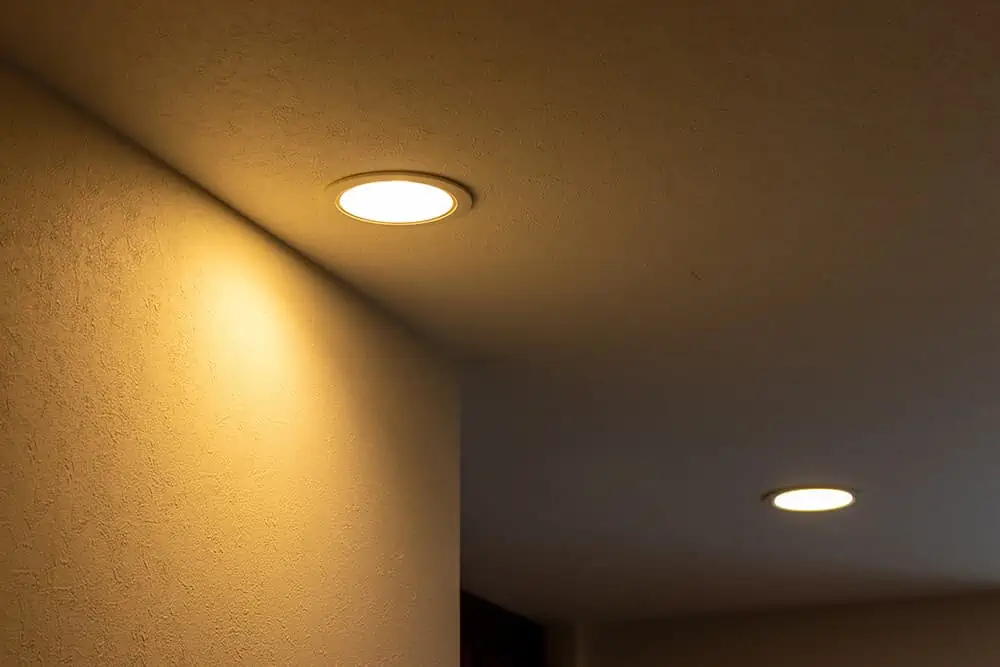
Application Of Downlight
Downlights are an excellent replacement for traditional bulky light fixtures. These lights are small in size, lightweight, and versatile in use. You can use these lights for primary lighting purposes, such as-
Ambient Lighting
Ambient lighting refers to the general lighting of your room. Usually, LED strip lights, tube lights and bulbs are used for ambient lighting. But downlights are undoubtedly a modern replacement for these lights. However, you must install multiple fixtures to the ceiling for a proper ambiance. The reason is that these downlights are very small in size, and a single fixture can’t illuminate an entire room. So, placing these small lights around the ceiling creates a soft, cozy glow in your room without direct glaring. And so these lights are excellent for ambiance lighting in bedrooms, hall rooms, shopping malls, hotels, reception, etc. For ambient or general lighting, you can install downlights following these measurements-
| Ceiling Height | Beam Angle | Downlight spacing |
| 3 meters | 60° to 120° | 1.5m to 3m |
Accent Lighting
You can use downlights as accent lighting to focus a particular object or area. For example, if you have special textures on your walls and want to pop them up, go for downlights. These lights are also great for highlighting artworks or pieces of your house. This way, it adds an extra effect to your ambiance.
Task Lighting
Downlights are also used as task lighting as these fixtures focus on a specific area. The most common example of this is kitchen lighting. Downlights are often used in the kitchen station or under the cabinet to provide sufficient lighting to the workstation. Here are some recommendations on the brightness of downlights for the different tasks-
| Task Lighting With Downlight | Recommended Illuminance |
| Canteen & entrance hallways | 160 lux |
| Food preparation | 240 lux |
| Reading & Office Task | 320 – 400 lux |
| Inspection Task | 600 lux |
| Hand tailoring & graphic art inspection | 1200 lux |
Decorative Lighting
Hanging downlights are pretty famous for decorative lighting. This adds dimension to your decorations. Besides, wall washers are also great for this purpose. You can also find colorful downlights for decorative lighting in your area.
Factors to Consider Before Choosing a Downlight
Before installing any downlight, it is crucial to choose the right fixture. Here are the factors to consider before choosing a downlight-
1. Ceiling Height
The height of the ceiling is the most crucial factor to consider for installing a downlight. You need to decide the bulb’s intensity, beam angle, and the number of lights keeping the height of the ceiling in mind. For example, if you are willing to install downlights for task lighting for a ceiling height of 4 meters, the recommended spacing is 2.5m to 3.5m. Again, if the ceiling height is 8 meters, a space of 3.5m to 5.5m between the lighting is perfect.
2. Number of Required Light
As downlights are very small, a single fixture for lighting an entire room is never enough. So, it is essential to know how many downlights your space requires. However, the number of lights depends on three factors. These are-
- The area of the room
- The intensity of the downlights
- Desired lighting effect (general lighting or task lighting)
If you have a big room, it will require more lights to illuminate the room properly. Again the number of lights also depends on the intensity of light and your intention of lighting. For example- you have a kitchen of 12 sq.m. Usually, a kitchen requires 150 – 200 lux for general lighting.
So, for a kitchen with an area of 12 sq.m, lux requirement = 12 sq.m * 200 lux = 2400 lumens. Now, if you have downlights that emit 400 lumens,
The number of required lights= 2400 lumens / 400 lumens = 6
So, you must install six downlights to illuminate your kitchen for task lighting.
3. Downlight Spacing
Downlight spacing indicates the space between the light fixtures. It is an essential factor to consider as it dramatically affects the intensity of output lighting. Usually, interior designers follow the 1m rule for spacing downlights. Yet the most professional way to find the required spacing is by dividing the ceiling height by 2.
Downlight Spacing = Ceiling height ÷ 2
However, here are some recommendations for downlight spacing for different ceiling heights-
| Ceiling Height | Downlight Spacing |
| 3 meters | 1.5m to 2m |
| 4 meters | 2.5m to 3.5m |
| 5 meters | 3m to 4.5m |
| 6 meters | 4m to 5.5m |
| 7 meters | 3m to 5m |
| 8 meters | 3.5 to 5.5m |
| 9 meters | 4m to 6.5m |
| 10 meters | 4.5m to 7m |
4. Lumens Per Wattage
Energy efficiency is a significant factor to consider before purchasing any downlight. You can find the efficiency of downlights by evaluating the lumen per watt. In this case, LED downlights are a great choice. They use less energy to produce brightness equivalent to traditional downlights. The below chart shows you a comparison of lumen per watt between LED downlights and incandescent lights-
| Lumens | Incandescent Downlight | LED Downlight |
| 450lm | 40 W | 6-9 W |
| 800lm | 60 W | 8 – 12 W |
| 1100lm | 75 W | 9 – 13 W |
| 1600lm | 100 W | 16 – 20 W |
| 2600lm | 150 W | 25 – 28 W |
From the above chart, you can observe that LED downlights are highly energy efficient. So, if you are looking for downlights, go for LEDs.
For more information, you can read Lumen to Watts: The Complete Guide.
5. Beam Angle
The beam angle indicates the measurement of the light-spreading areas. It is calculated in degrees. A greater value of the bream angle illuminates a larger part of the room. However, with the increase of the bream angle, light intensity decreases. That is why, for task lighting, a lower beam angle is preferred to concentrate the light on a particular region.
Wide beam angle = 60 degrees or more
Narrow beam angle = Less than 60 degrees
The beam angle requirements vary with the lighting requirements. For example- if you want general lighting for your living room, 60 degrees will work. It will give your space a soft and diffused glow. But this angle will not work for the kitchen.
The kitchen requires downlights with lower beam angles for task lighting. It is where you wash dishes, cook and work with a knife for chopping and cutting. So, it would be best to choose concentrated lighting for this area. And for this, downlights with 25 degrees beam angle will work.
Yet, if you are confused with the beam angle, go for somewhere between 60° to 120°. These measurements are ok for the general lighting of your room.
6. Color Temperature
Downlights are great for interior decoration. And the color of these lights depends on the color temperature. Higher the color temperature, the cooler tone it gives. The below charge shows you the color temperature range for light colors-
| Color Temperature | Light Color |
| 2700 K – 3300 K | Warm White |
| 3300 K – 5300 K | Cool White |
| 6500 K | Daylight |
Downlights with warmer tones are ideal for areas like bedrooms, living rooms, drawing rooms, etc. these lights create a cozy and comfortable ambiance in your room. Again, the cool tone downlights are great for task lighting in the kitchen and reading room. However, color preference is all about personal choice. You can go for the one that suits you best.
For more information, you can read How to Choose LED Strip Color Temperature? and Best Color Temperature for LED Office Lighting.
7. Color Rendering Index
Color Rendering Index or CRI rating indicates the color accuracy of artificial lighting in comparison to natural lighting. This measurement ranges from 0 – 100. Higher the rating the better color accuracy it provides. So, choosing downlights you must consider this factor. The areas like kitchen, vanity lighting require a higher CRI rating. Again, when lighting a restaurant, higher CRI rating is needed as it deals with food. Besides, showrooms or outlets also require higher CRI.
At least a CRI>80 is required.
8. IC Rating
When purchasing downlights like- recessed or can lights, you should check whether the bulb is IC rated. IC rating stands for ‘Insulation Contact’. So, the downlights with IC marking are ideal for installing on insulated surfaces. It is crucial because insulated walls have flammable materials that quickly catch fire. In this case, if you install a non-IC-rated downlight in it, there is a higher possibility of a fire breakout. So, always check the IC rating before purchasing a downlight for your apartment.
For more information, you can read IC Vs. Non-IC Rated Recessed Light Fixtures.
9. IP Rating
IP stands for Ingress Progress. This two-digit number determines the level of protection against liquid and solid ingress. The higher the number of ratings, the greater the level of security. Here are some IP rating suggestions for a different area of your house.
| IP Rating | Area |
| Bedroom | IP20 |
| Kitchen | IP44 |
| Bathroom | IP65 |
Bedroom lighting doesn’t come in contact with water, so IP20 is ideal for this area of your house. IP44 would be perfect for protecting against heavy moisture exposure in the kitchen. You can also go for IP65 if the light fixture faces water jets, for example- the sink area. As per bathroom downlights, IP65 or adobe will work fine. However, different bathroom zones have specific IP requirements. Check out IP Rating: The Definitive Guide to know more about these factors.
10. Warranty
Warranty, directly and indirectly, determines the quality of a fixture. So, it is crucial to consider the warranty of the downlights. LED downlights can come with a guarantee of 2 – 5 years. However, the warranty policies vary from brand to brand.
LED Vs. Halogen Downlight
LED downlights are the most popular category of downlights. In contrast, halogen lights are traditional ones. There are many differences between these two types of downlights. These areas follow-
- Energy Consumption: The energy consumption of lighting is measured in watts per hour. A LED downlight uses about 7 – 20 watts/per hour. In contrast, a halogen downlight can consume 35 – 500 watts/hour to emit the same amount of lighting. That is, halogen lights use nine times more electricity than LEDs. So, undoubtedly, LED downlights are great as they save your electricity bills by many times.
- Durability: Though the initial cost of a LED downlight is 3-4 times greater than the halogen ones, they are more worthy in terms of durability. Usually, a LED downlight can last for up to 50,000 hours. Further, it comes with better warranty policies. In contrast, halogen lights last for just 1000 – 2000 hours. So, comparing the lifespan, LED downlights are more durable than halogen downlights.
- Quality & Safety: LED downlights don’t get overheated while operating. These lights are cool so that you can use them on all applications. Besides, they are versatile and have advanced features that traditional bulbs lack. And these downlights are much more effective in concentrating the light on a particular erection. In contrast, halogen lights have filaments that quickly get hot. And placing these fixtures in areas like the bathroom or kitchen can be dangerous.
So, comparing these two lights, LEDs give better quality and safety than halogen bulbs.
For more information, you can read Halogen vs. LED Bulbs: How To Choose?
How To Install Downlights?
Downlights are usually installed directly into the ceiling, which seems really complex. Here are the steps following which you can install downlights for your house-
Step:1- Marking the Ceiling for Installation
First, you need to mark the places where you will install the downlights. Consider the height of the ceiling, brightness of the light, and downlight spacing, and determine the number of fixtures. Now mark the spots keeping equal spaces in between.
Step:2- Cutting the Holes for Downlights
Once you have marked the installation spots, cut or drill holes in those areas. Usually, false ceilings are made to install downlights as they are essays to cut. To do so, consider the diameter of the fixture and cut accordingly.
Step:3- Wiring
Downlights are wired in radical circuits. The wiring must run from the first switch to the first light and continue up to the last light of the course. The wiring downlight is complex. So, it is better to go for professional help.
Step:4- Inserting Downlights Into The Ceiling
Usually, there is spring on the side of the downlights. All you need to do is squeeze the back part of the light into the hole. As the spring fits into the hole, it pushes down the upper side of the downlight holding it into place. Once the lights are installed into the holes, turn them on and ensure they glow correctly. If you notice any flickering issues, check the wiring.
In this way, following these simple steps, you can quickly install downlights.
Maintenance of Downlights
To keep up the performance of the downlight, you should maintain them properly. Here are the tips for maintaining your downlights-
- Avoid wet cleaning
Always clean your downlights with a dry cloth. Never clean it with water or any other liquid substances, as it will affect the electrical component of the fixture. However, you can soak a dry cloth and clean the fixtures, but make sure the light is off. Before turning the light on, ensure it is properly dried. Avoid cleaning while the fixture is on.
- Avoid frequent switching
Frequent switching on and off can hamper the performance of the light fixture. Though LED downlights are 18 times more durable than traditional lighting, frequent switching will affect the internal component of the fixture. Eventually, it can hamper the performance of light and decrease its durability.
- Don’t change the parts of the lamp
After cleaning, place all the parts of the downlight as it is. There should be no wrong installation or missing part of the lamp. Besides, don’t replace the lamps until they show any major issues.
- Moisture free environment
Downlights often face moisture condensation issues. So, if you place your lighting in a damp area like the bathroom or kitchen, ensure they are moisture-proof. Buying fixtures with a higher IP rating will help in this case.
Why Is Downlight So Popular For Indoor Lighting?
When it comes to interior lighting, downlights are the most popular kind. These lights come in various forms and colors to use for several purposes. You can use them for lighting residential and commercial areas. Here is the reason for such popularity of downlights for indoor lighting-
Space Illusion: Downlights are excellent for creating the illusion of space. But how? If you have a small room or narrow areas, i.e., a hallway, you can make the area appear wider using recessed downlights. These lights are small in size. And when multiple fixtures are installed in the ceiling, it creates a diffused and soft glow. Such a lighting effect adds an extra dimension to your area, making it appear big.
Versatile Design: You can find downlights in several designs. These lights are multi-functional and ideal to use for various purposes. You can use them as general lighting for your room. Task lighting is also possible with downlights. Besides, if you want decorative lighting for the interior, downlights are your go-to solution. They come in different designs that make your house look modern and sleek.
Highlighting: Do you want to highlight the artwork on your walls or the exclusive showpieces in your drawing room? Go for downlights with a lower beam angle to focus on these specific elements. These lights emit concentrated lighting that focuses on the elements grabbing the visitors’ attention. You can also use these lights as wall washers to highlight the unique textures of your walls.
Sophisticated Outlook: Using downlights as ambient lighting can make your area look sophisticated. These fixtures are an excellent replacement for traditional tube lights. You can use them for your bedroom, living room, or bathroom. These lights are also greater for commercial uses.
Common Issues With Downlights & Their Solution
While using downlights, you can face some common issues. These follow along with its solution-
Downlight Flickering
If you have downlights, flickering is the most common issue you will face. The reason for this issue and its solution are as follows-
Causes:
- Loose Wiring: Downlights’ wires can often loosen, causing the fixture to flick. It can be caused due to overuse of the lighting or some internal issues while installing the fixture.
- Dimmer Switches: Downlights are connected to the dimmer switch. And in case the dimmer is not compatible with the fixture, it will cause flickering.
- Poorly Made LEDs: Sometimes, the downlights may come with low-quality LEDs. Due to this manufacturer’s defect, you can face flickering issues with your downlight.
- Power Surges: A power surge means a sudden increase in the light voltage that can harm the fixture. If your house or office has such issues, it may cause the downlight to flicker.
- Old Electrical Panels: Older apartments have outdated electrical panels that can’t meet new-generation electronics’ electricity demand. If your house has such panels, it can cause light flickering.
Solution:
- Ensure the wirings are ok; if there are any issues, contact an electrician.
- Replace the dimmer with a standard switch.
- If you find any problem with the bulbs, replace them with new ones.
- Install a surge protector.
- If you have an old house with old electrical panels, replace it with a newer one.
- Consult an electrician if you can’t find the reason and solution for your flickering light.
Sudden Shut Down Or Fire Breakout:
You may find your downlight shuts down suddenly. This may be due to several reasons. Again if you have recessed lights, you can also have a fire hazard. Here are the reasons for such issues-
Causes:
- Non-IC Rated: If the downlights are placed on an insulated surface, you must have IC-rated downlights. Non-IC-rated downlights get quickly overheated. And when these substances come in contact with insulation, they can catch fire.
- Wrong Wattage: When a bulb of higher wattage is installed as a downlight, it overheats the fixture. And when the institution gets excessively heated, its thermal protection shuts the bulb off.
Solution:
- Choose the right wattage for your downlight.
- If you have an insulated house, ensure the downlights are IC rated.
- For non-IC-rated downlights, keep at least a 3 inches gap between the fixture and the insulation. It is better to cover the bulb with a heat-protected cover.
FAQs
You can use a dimmer to lower the brightness level on your LED downlight. In this case, you will find two dimmer switches: trailing edge and leading age. LED downlights are more compatible with trailing edges. However, all dimmers may not suit every downlight, so choose the ideal one for your fixture.
The number of required downlights depends on the area of your room. So, if you have a big room, you will require more lighting. Yet, the easiest way is to install one downlight for every 1.4 sq.m of area. Five downlights will be enough if your room area is 5sq.m. However, there are no set rules for calculating these; you can give preference to your liking. But remember to consider the brightness of the fixtures while choosing the number of lighting.
The lumen requirement of downlights varies with lighting purposes. For example- if you want general lighting for your bedroom, a luminous intensity between 25 and 50 lux would work. Again for kitchen lighting, 240 lux is perfect.
To choose the suitable downlight, you must consider a few factors like- beam angle, ceiling height, brightness, CRI, IC, IP ratings, etc. If you want task lighting, go for a downlight with a narrow beam angle, 60° will be ok. Again, if the lighting is for areas that come in contact with water, i.e., the bathroom, go for a higher IP rating. IC rating is also a factor to consider in choosing downlights if you have an insulated house. Additionally, regarding energy efficiency, LED downlights are your best option.
Lastly, light color also affects the mood of your ambiance. For example- if you want a downlight for your bedroom, go for a warmer tone ranging from 2700 K – 3300 K. This will create a cozy and comfortable vibe. Again, for reading rooms, cool tone light will keep you energized. This way, considering your lighting requirements, you can choose suitable downlights for your space.
Downlights can be of different types based on their installation process and design. For example- recessed lights suspended downlights, surface-mounted downlights, etc. Besides, there are other sub-variants, such as semi-recessed lights and adjustable downlights. Downlights are also available in different designs and patterns. These are usually used for decorative lighting, i.e., pendant downlights.
Light color preference varies from person to person. However, you can take 3000 K color temperature, which is ideal for downlighting. It gives a warm white illumination, suitable for a bedroom, bathroom, or living area. Besides, this lighting is also ideal for commercial areas like- hotels, restaurants, and malls. Yet, light color is more about personal taste and choice. For example, warm color lighting works best if you want to create a cozy ambiance. Again for task lighting like- reading, and cooking, most people prefer cool lighting. You can also go for dimmable downlights to adjust the illumination per your preferences.
Placing downlights all over the ceiling is a bad practice. It gives your room a scattered look. To give the best ambiance to your room, put the downlight on the edges of our room. It looks excellent, giving your room a spacious vibe. You can also install these lights above the drawers and closets of your bedroom. Besides, it is also great to use these lights for accent lighting. For example, try highlighting any specific area of your bedroom, i.e., a painting or any art piece.
Yes, you can use downlights in the bathroom. But in this case, IP rating is an essential factor to consider. It ensures your lights are protected when coming in contact with water. So, the higher the IP rating, the better its protection. However, the IP requirement of all bathroom zones is different. Yet, IPX5 or above will work.
The distance between the downlights depends on the ceiling height of your room. To choose the ideal downlight spacing, divide the ceiling height by 2. That is the distance between downlights = Ceiling Height/2. So, if your room height is 8 feet, the spacing between the downlights will be 4ft.
Downlights with outdated technology, like halogen, can use a lot of electricity. But LED downlights are highly energy efficient. They use nine times less electricity than halogen ones. Besides, IC-rated downlights are also great for minimal energy use. These fixtures are entirely airtight and have a thermal protection system that prevents them from overheating. And thus doesn’t allow excessive current flow and saves your electricity bills.
IC rating is the most important factor to consider for installing recessed downlights. If you have an insulated house, IC-rated recessed lights are essential. If you install a non-IC-rated fixture, it can cause a fire to break out anytime. Recessed downlights are attached directly to the ceiling. And when these fixtures get overheated, they can catch fire coming in contact with the flammable insulation. But IC-rated lights have a thermal protection system that makes them fire hazard-free. So, to ensure your safety, always check the IC rating before installing any recessed downlights. However, you can use non-IC-rated recessed downlights if your house is not insulated.
Downlights indicate lighting that gives a downlight illusion. These can be built-in ceiling lighting or suspended. In contrast, recessed lights are downlights directly attached to the ceiling. In that sense, recessed lighting is one of the categories of downlights. However, they are often used as synonyms.
Good quality LED downlights are the ones that are energy-efficient and durable. The energy efficiency of lights is calculated by lumen per watt. The fixtures that provide higher lumen value using minimal energy are the ones with higher quality.
Final Quote
Downlights are in great demand for indoor lighting. They give a sophisticated outlook to your area. These lights can be different based on their features and installation process. Besides general lighting, downlights are also excellent for task lighting. You can install them in your bedroom, kitchen, bathroom, or reading area. Additionally, if you have small or narrow spaces in your home, you can use these fixtures to create an illusion of space.
Nevertheless, for installing downlights, you need to consider several factors. These include the number of lights based on the ceiling height and brightness of the bulb, waterproof features for areas like the bathroom, and more. Besides, IC rating is the most crucial downlight factor if you have an insulated house. So, consider these factors before choosing a suitable downlight for your area.
LEDYi manufactures high-quality LED strips and LED neon flex. All of our products go through high-tech laboratories to ensure the utmost quality. Besides, we offer customizable options on our LED strips and neon flex. So, for premium LED strip and LED neon flex, contact LEDYi ASAP!



